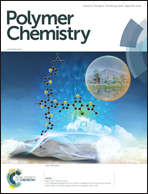Terpyridine-functionalized stimuli-responsive microgels and their assembly through metal–ligand interactions†
Abstract
We developed a terpyridine-functionalized microgel (tpy-mG) for its supramolecular assembly. Tpy-mG was synthesized by amidation between 3-(4-([2,2′:6′,2′′-terpyridin]-4′-yl)phenoxy)propan-1-amine and carboxylates of a thermo-responsive p(NIPAM-co-MAA) microgel (A-mG), which was synthesized by emulsion polymerization. After decorating terpyridine, its effects on the hydrodynamic radius, volume phase transition temperature (VPTT), and the colloidal stability of the microgel were investigated. Tpy-mG can be assembled reversibly with several metal ions (Ni2+, Fe2+, Co2+, or Zn2+), and interestingly the assembled tpy-mG-M2+ showed different rheological properties depending on the metal ion type; the weakly bound ions (Co2+, Zn2+) indicated fast dynamics for “inter-particular” exchange, resulting in much higher storage (G′) and loss (G′′) moduli. Photocatalysts such as Ru dyes can be easily introduced into tpy-mGvia metal–ligand interactions, and the photooxidation of benzylamine was tested. The free Ru dye showed almost the same conversions at 25 and 50 °C, whereas the assembled Ru-tpy-mG-Mg2+ displayed reduced conversion at 50 °C (>VPTT). This is suggested to be due to the collapsed or “locked” structure around the photocatalytic center (Ru). Tpy-mG can be utilized as a good platform for developing responsive functional materials via reversible metal–ligand complexation.



 Please wait while we load your content...
Please wait while we load your content...